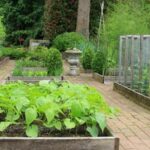Are you interested in bringing the joy of gardening indoors and growing your own vegetables? Look no further.
In this comprehensive guide, we will explore the world of indoor vegetable gardening, including the benefits, essential tools and supplies, best vegetable varieties, planting and maintenance tips, common challenges and solutions, harvesting and enjoying your garden’s produce, as well as creative ways to incorporate homegrown vegetables into your cooking. Whether you’re a beginner or experienced gardener, this article will provide valuable insights into choosing the right vegetables for indoor gardening.
When it comes to indoor vegetable gardening, choosing the right vegetables is crucial for success. Not all vegetables are suited for indoor cultivation due to space constraints and light requirements. However, with careful selection and proper care, you can enjoy a bountiful harvest of fresh, organic produce right in your own home. Whether you’re interested in salad greens or root vegetables, we’ll cover everything you need to know about selecting the perfect vegetables for your indoor garden.
One of the key benefits of growing vegetables indoors is the ability to have access to fresh produce year-round. Indoor gardening also promotes sustainability by reducing food miles and minimizing wastage. Additionally, tending to a mini-vegetable garden indoors can be a therapeutic and rewarding experience. With our guide to choosing the right vegetables for indoor gardening, you’ll be on your way to enjoying all these benefits and more.
The Benefits of Growing Vegetables Indoors
Indoor gardening offers a host of benefits, not only for the environment but also for your own health and convenience. By growing vegetables indoors, you have the opportunity to create a sustainable and eco-friendly way of obtaining fresh produce all year round. Additionally, indoor gardening allows you to have full control over the growing conditions, ensuring that your vegetables are free from harmful chemicals and pesticides.
One of the key advantages of indoor vegetable gardening is the health benefits it provides. By growing your own vegetables at home, you can ensure that they are full of nutrients and free from harmful substances. This means that you can enjoy a diet rich in vitamins, minerals, and antioxidants without having to worry about harmful residues often found in store-bought produce.
Furthermore, indoor vegetable gardening is incredibly convenient. You can easily access your fresh produce without having to leave home or deal with weather-related challenges. This not only saves time and money but also reduces your carbon footprint by eliminating transportation emissions associated with getting produce from the grocery store to your home.
| Benefit | Statistic |
|---|---|
| Environmental Impact | A study by NASA found that houseplants can remove up to 87% of air toxins in a 24-hour period. |
| Sustainability | If every American household grew just one food plant indoors, it would reduce annual oil consumption by an estimated 1.45 billion gallons. |
Essential Tools and Supplies for Indoor Vegetable Gardening
When it comes to indoor vegetable gardening, having the right tools and supplies is essential for success. Here is a list of must-have items to help you get started:
- Containers: Choose containers that are suitable for the size of the vegetable you want to grow. Ensure that they have drainage holes to prevent waterlogging.
- Soil: Opt for a high-quality potting mix that is well-draining and rich in nutrients. Consider using a blend specifically designed for vegetables for indoor gardening.
- Grow Lights: Since natural light may be limited indoors, invest in grow lights to provide your vegetables with the adequate light they need to thrive.
- Watering Can or System: A watering can or system (such as a drip irrigation system) will ensure that your vegetables receive the right amount of water without over-saturating the soil.
- Fertilizer: Use a balanced fertilizer specifically formulated for vegetable plants, following the instructions on the packaging for best results.
In addition to these essential items, having a few gardening tools on hand can make maintenance tasks easier and more efficient:
- Hand Trowel: Ideal for transplanting seedlings and maintaining container gardens.
- Pruning Shears: Useful for trimming back overgrown foliage and harvesting mature vegetables without damaging the plant.
- Gloves: Protect your hands from soil, moisture, and potential garden pests while tending to your indoor vegetable garden.
With these tools and supplies at your disposal, you’ll be well-equipped to start your indoor vegetable garden and enjoy a bountiful harvest of fresh, homegrown produce in no time.
The Best Indoor Vegetable Varieties
When it comes to indoor vegetable gardening, choosing the right vegetables is essential for success. There are numerous vegetable varieties that can thrive indoors, providing a bountiful harvest for your culinary needs. From vibrant salad greens to hearty root vegetables, there is a wide range of options to consider when planning your indoor garden.
Salad Greens
One of the most popular choices for indoor vegetable gardening is salad greens. Varieties such as lettuce, spinach, arugula, and kale are well-suited for indoor growing due to their compact size and relatively quick harvest time. These leafy greens can be grown in containers or vertical gardens, making them a perfect choice for limited space.
Herbs
While not technically vegetables, herbs are an essential part of any indoor garden. Many herbs, such as basil, parsley, mint, and cilantro, can be grown indoors with ease. They add incredible flavor to your dishes and can be grown in small pots on windowsills or under grow lights.
Root Vegetables
While it may seem challenging to grow root vegetables indoors due to their need for deep soil and ample space, some varieties can thrive in containers. Carrots, radishes, and beets can be successful crops for indoor gardening if provided with the right depth of soil and adequate watering.
Incorporating a variety of vegetable types into your indoor garden will not only provide you with a diverse range of produce but also create an aesthetically pleasing and functional space within your home. With careful selection and proper care, you can enjoy a thriving indoor vegetable garden throughout the year.
Planting and Maintenance Tips for Success in Indoor Vegetable Gardening
When it comes to growing vegetables indoors, proper planting and maintenance are essential for a successful harvest. Whether you have limited outdoor space, or you simply want to enjoy fresh produce year-round, indoor gardening can be a rewarding and sustainable hobby.
Here are some tips for successfully planting and maintaining your indoor vegetable garden:
1. Choose the right containers: Select containers that provide adequate drainage and enough room for the roots to grow. Options like plastic pots, fabric grow bags, or even repurposed containers can work well for different types of vegetables.
2. Use high-quality soil: Invest in good quality potting mix to ensure that your vegetables receive the nutrients they need to thrive. Avoid using regular garden soil, as it may not provide the right balance of nutrients and could lead to poor drainage in containers.
3. Provide adequate light: Vegetables for indoor gardening require at least 6-8 hours of direct sunlight each day. If natural light is limited, consider supplementing with grow lights to ensure that your plants get the light they need to grow healthy and strong.
4. Monitor water and humidity levels: Overwatering is a common issue with indoor gardening, so be sure to check the moisture level of the soil regularly before watering. Additionally, some vegetables may benefit from increased humidity levels, especially during winter months when indoor air tends to be dry.
By following these planting and maintenance tips, you can increase your chances of success with indoor vegetable gardening and enjoy a bountiful harvest of fresh produce right from your own home.
Common Challenges and Solutions for Indoor Vegetable Gardening
One of the common challenges in indoor vegetable gardening is inadequate light. Since most vegetables need at least 6 hours of sunlight a day, it can be difficult to provide that level of light indoors. A solution to this challenge is to invest in grow lights, which can provide the necessary spectrum of light for optimal growth. LED grow lights are energy-efficient and can simulate natural sunlight for your vegetable plants.
Another challenge is maintaining the right temperature and humidity levels indoors, especially during extreme weather conditions. One solution is to use a hygrometer to monitor humidity levels and a heater or fan to control temperature fluctuations. It’s also important to keep the indoor environment well-ventilated but free from drafts that may harm your vegetable plants.
Pest infestation can also be a problem in indoor vegetable gardening. To prevent pest problems, make sure to regularly inspect your plants for any signs of infestation and use organic pesticides or insecticidal soaps when necessary. Another solution is to introduce beneficial insects, such as ladybugs or predatory mites, that can help control pest populations in a natural way.
| Challenge | Solution |
|---|---|
| Inadequate light | Invest in grow lights (LED) |
| Maintaining temperature and humidity | Use a hygrometer, heater or fan |
| Pest infestation | Regular inspection and use of organic pesticides or introduce beneficial insects |
Harvesting and Enjoying Your Indoor Vegetable Garden
Timing Your Harvest
When it comes to harvesting your indoor vegetables, timing is key. Different vegetables have different optimal harvest times, so it’s important to familiarize yourself with the specific needs of each plant.
For example, leafy greens like lettuce and spinach are best harvested when the leaves are young and tender, while root vegetables like carrots and radishes should be harvested once they have reached the desired size. Understanding the optimal harvest time for each vegetable will ensure that you enjoy the best flavor and texture from your homegrown produce.
Preserving Your Harvest
Once you’ve harvested your indoor vegetables, it’s important to know how to properly store and preserve them. Proper storage techniques can help extend the shelf life of your produce and reduce food waste.
For example, many leafy greens can be stored in a plastic bag in the refrigerator crisper drawer, while root vegetables may benefit from a cool, dark place such as a basement or root cellar. Additionally, consider exploring preserving methods such as freezing or pickling to enjoy your harvest throughout the year.
Enjoying the Fruits of Your Labor
There’s truly no greater satisfaction than enjoying a meal made with ingredients you’ve grown yourself. From crisp salads made with freshly picked lettuce and tomatoes to hearty soups featuring homegrown carrots and onions, there are countless ways to incorporate your indoor-grown vegetables into delicious meals. Not only does homegrown produce offer superior flavor and freshness, but it also allows you to connect more deeply with your food and appreciate the effort that goes into cultivating it.
As you continue on your indoor vegetable gardening journey, remember that harvesting is not just about plucking vegetables from their vines – it’s about savoring the rewards of your hard work and enjoying the bountiful flavors of homegrown produce.
Creative Ways to Incorporate Homegrown Vegetables Into Your Cooking and Meals
Growing your own vegetables indoors not only provides you with fresh and healthy produce, but it also gives you the opportunity to get creative in the kitchen. Incorporating homegrown vegetables into your cooking and meals can add a special touch to your dishes and elevate the flavors of your favorite recipes.
One creative way to use your indoor-grown vegetables is by making veggie-packed smoothies and juices. Leafy greens like spinach, kale, or lettuce, along with cucumbers, carrots, and beets can all be easily incorporated into delicious and nutritious drinks. These homemade beverages are a great way to start your day with a burst of vitamins and minerals from your indoor garden.
Another way to utilize your indoor-grown vegetables is by creating colorful and flavorful salads. Mix fresh salad greens like arugula or microgreens with sliced tomatoes, cucumbers, radishes, and bell peppers for a vibrant and nutritious dish. You can even add some herbs like basil or cilantro for an extra kick of flavor. With homegrown vegetables, you have the freedom to experiment with different combinations and create unique salads that reflect your personal taste.
Lastly, consider using your indoor-grown vegetables in homemade soups, stir-fries, or roasted vegetable dishes. Root vegetables like carrots, potatoes, and onions are perfect for hearty soups and stews, while bell peppers, zucchini, and eggplant can be used in flavorful stir-fries. Roasting a mix of homegrown veggies with olive oil and seasoning can turn them into a delicious side dish or a topping for pizzas and pasta.
Incorporating homegrown vegetables into your cooking not only allows you to savor the flavors of freshly harvested produce but also encourages creativity and experimentation in the kitchen. Whether it’s through smoothies, salads, soups, or other dishes, there are countless ways to enjoy the fruits of your indoor gardening labor in delicious meals at home.
Conclusion
Embracing the joy and satisfaction of indoor vegetable gardening can be a rewarding experience, providing not only fresh produce but also mental and physical benefits. The convenience and easy access to homegrown vegetables can promote healthier eating habits and reduce our carbon footprint. By choosing the right vegetables for indoor gardening and utilizing essential tools and supplies, anyone can enjoy the benefits of growing their own produce year-round.
The process of planting and maintaining an indoor vegetable garden may come with its challenges, such as finding optimal lighting conditions or controlling pests. However, with patience and dedication, these challenges can be overcome to ensure a successful harvest. Once your vegetables are ready to be enjoyed, incorporating them into your cooking and meals can add flavor, nutrition, and pride in knowing exactly where your food comes from.
In conclusion, indoor vegetable gardening offers countless benefits for both the environment and our well-being. Whether you live in an apartment or have limited outdoor space, anyone can take part in cultivating their own fresh produce indoors. By embracing this practice, we not only nurture our connection to nature but also gain a sense of accomplishment in providing for ourselves through sustainable means. So go ahead and start your indoor vegetable garden today – you won’t regret it.

If you’re looking to get into vegetable gardening, or are just looking for some tips on how to make your current garden better, then you’ve come to the right place! My name is Ethel and I have been gardening for years. In this blog, I’m going to share with you some of my best tips on how to create a successful vegetable garden.





